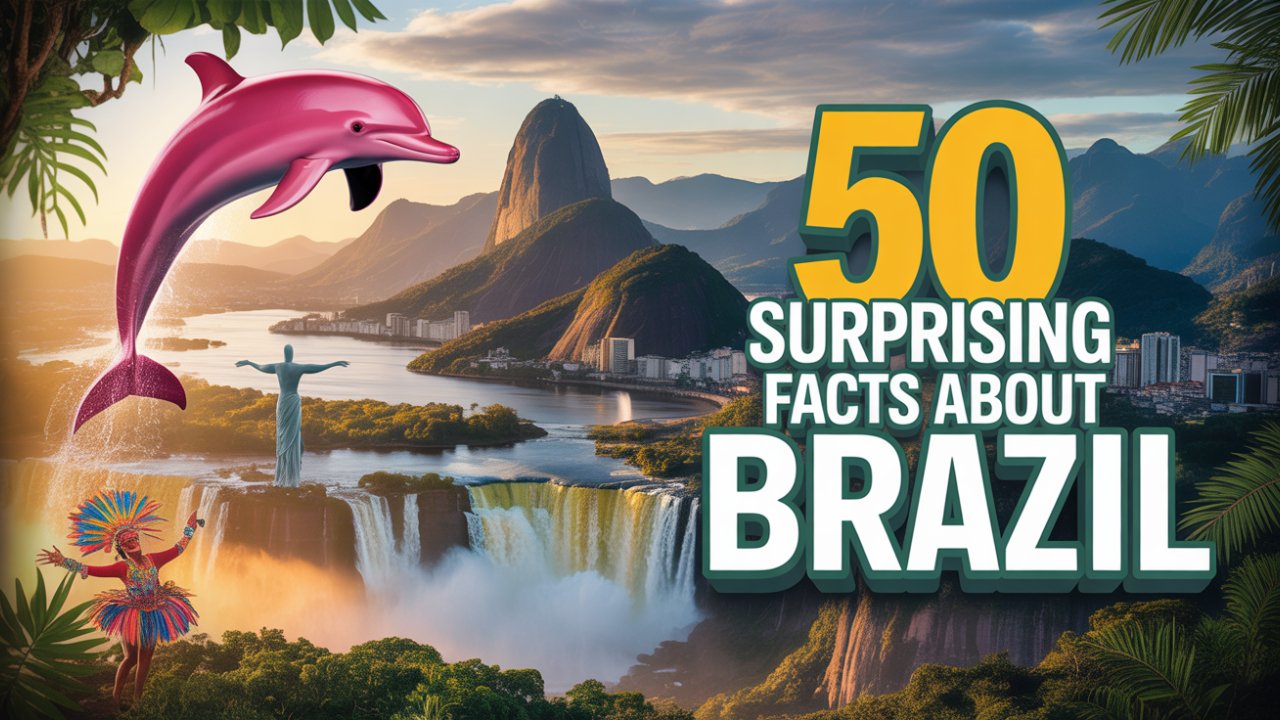So, you think you know Brazil? I bet you’re picturing Carnival, beaches, and soccer. And hey, you’re not wrong! But that’s just the postcard version. What if I told you the real Brazil is a land of hidden cities, biological marvels, and cultural fusions that sound like they’re straight out of a novel? We’re about to count down 50 facts that will completely flip your script on this incredible country. From a river that flows the wrong way to the world’s biggest party that isn’t Carnival, get ready to see a side of Brazil you never knew existed.
Let’s get into it.
50. The National Drink is Made from Sugarcane Liquor
We’ll start with a taste of Brazil’s signature cocktail: the Caipirinha. This isn’t just a drink; it’s a way of life. It’s made from cachaça—a potent spirit distilled from fermented sugarcane juice—mixed with sugar and lime. Simple, powerful, and refreshing, it’s the true taste of Brazil in a glass. While you might think of coffee or beer, it’s the Caipirinha that truly captures the nation’s spirit of hospitality and friendship.
49. A City of Monumental Street Art
Lots of cities have graffiti, but São Paulo has transformed it into a world-class art form. Forget a few tags under a bridge; we’re talking about massive, building-sized masterpieces stretching for entire city blocks. The city is home to the world’s largest street art mural, and artists from across the globe come here to make their mark, turning the concrete jungle into a vibrant, ever-changing outdoor gallery.
48. It Hosts the Largest Japanese Festival Outside of Japan
Here’s a cultural curveball you probably didn’t see coming. São Paulo is home to the largest Japanese community outside of Japan, and their influence is huge. Every year, the city hosts the Festival do Japão, the biggest Japanese festival on the planet that isn’t actually in Japan. For a few days, the sounds of taiko drums and the sights of traditional folk dances take over, blending perfectly with the city’s tropical energy. It’s a beautiful and slightly surreal testament to Brazil’s amazing multiculturalism.
47. Secrets of Ancient Amazonian Cities
For centuries, everyone thought the Amazon was a pristine wilderness, untouched by any large-scale human civilization. Well, recent discoveries have blown that idea out of the water. Using advanced Lidar technology, scientists have found the ruins of huge, ancient cities hidden under the jungle canopy. These weren’t just villages; they were complex urban centers with roads, canals, and even pyramids, suggesting the Amazon was once home to millions of people in highly organized societies.
46. Its Coastline Hides Sunken Treasures
Brazil’s long and storied coastline has been a major shipping route for centuries, and not every ship made it to its destination. Off the coast of beaches like Praia do Cassino, the shallow waters are a graveyard for historic shipwrecks. These sunken vessels, some hundreds of years old, create a haunting underwater museum. For divers and history buffs, exploring them is a direct glimpse into the country’s turbulent maritime past.
45. Hundreds of Indigenous Languages are at Risk
While Portuguese is the official language, it’s just one of hundreds spoken across the country. Brazil is home to an incredible diversity of Indigenous languages, each holding unique histories, cultures, and ancient knowledge. Tragically, many of these languages are now endangered, with some spoken by only a handful of elders. This silent crisis unfolding in the Amazon represents the potential loss of irreplaceable cultural heritage.
44. The River That Refuses to Mix
Near the Amazonian city of Manaus, one of nature’s strangest shows happens daily. It’s called the “Meeting of Waters,” where the dark, slow-moving water of the Rio Negro meets the sandy, faster-flowing Rio Solimões. But here’s the weird part: they don’t mix. For an incredible six kilometers, the two rivers flow side-by-side in the same channel, creating a perfectly defined, two-toned ribbon of black and brown. The stark difference in their temperature, speed, and density keeps them separate in a marvel you can even see from space.
43. The Amazon is Home to Pink Dolphins
The Amazon River Basin is full of bizarre and wonderful creatures, but maybe none are as magical as the Boto, or the pink river dolphin. And no, it’s not a myth—these animals are real. They are a species of freshwater dolphin that can have a striking pink color. Scientists are still debating the exact reason for their unique hue, but seeing one is an enchanting and rare experience.
42. The Forest That Floats
During the Amazon’s intense rainy season, something incredible happens. The rivers swell so much that they flood massive parts of the rainforest, creating a bizarre and beautiful ecosystem called “igapó,” or flooded forests. For months, the forest floor is submerged under several feet of water, and trees become part of an aquatic world. Life simply adapts, with fish swimming between tree trunks in a temporary, waterlogged wilderness.
41. The World’s Biggest Party Isn’t Rio’s Carnival
While Rio’s Carnival is legendary, it’s not the biggest. That title belongs to the “Galo da Madrugada” (Rooster of the Dawn) parade in Recife. Recognized by the Guinness Book of World Records as the largest Carnival street party on Earth, this single parade attracts millions of people. It’s a tidal wave of humanity, music, and pure joy that completely consumes the city in a celebration of truly epic proportions.
40. The Original Home of the Rubber Tree
The modern world was, in many ways, built on rubber, and for a long time, the Amazon rainforest was its only source. The rubber tree is native to this region, and its discovery kicked off a massive economic boom in the late 19th and early 20th centuries. This era brought incredible wealth to cities like Manaus, which famously built an opulent opera house in the middle of the jungle. It also brought immense suffering and exploitation, forever changing the region’s social and economic landscape.
39. A Nut Tree That Outlives Generations
Deep in the Amazon stands a true giant of the plant world: the Brazil nut tree. These magnificent trees are among the longest-living organisms in the jungle, with some estimated to be over 500 years old. They can soar to staggering heights of over 160 feet. What’s more, their nuts can only be produced in pristine, untouched forests, making them a powerful symbol of the Amazon’s delicate and irreplaceable biodiversity.
38. The Land of Deadly Creatures
The Amazon’s beauty is matched only by its danger. It’s home to an unsettling collection of the world’s most formidable creatures. Giant green anacondas, the heaviest snakes on Earth, lurk in the water. Venomous pit vipers and coral snakes blend into the forest floor. And, of course, there are the legendary flesh-eating piranhas, which can strip an animal down to the bone in minutes. It’s a place where you definitely need to watch your step.
37. A Fish with Teeth on Its Tongue
The rivers of the Amazon are home to one of the largest freshwater fish in the world, the Arapaima, also known as the Pirarucu. This prehistoric-looking giant can grow up to 3 meters long and weigh over 200 kilograms. But its size isn’t its only odd feature. The Arapaima has teeth not just in its jaw, but also on its tongue. This bizarre adaptation helps it crush prey, adding another layer of weird to the already strange wildlife of the Amazon.
36. The Forest That Makes Its Own Rain
The Amazon rainforest is so massive and powerful that it actually creates its own weather. Through a process called transpiration, the billions of trees in the forest release enormous amounts of water vapor into the air. This moisture forms clouds, which then produce rain. It’s estimated that the forest generates about half of its own rainfall in a self-sustaining cycle that’s critical to both the regional and global climate.
35. Home to the World’s Largest River Island
At the mouth of the Amazon River lies Marajó Island, a place of almost unbelievable scale. It’s the largest river island in the world, roughly the size of Switzerland. This massive landmass is its own unique biome, with huge savannas, mangrove swamps, and a distinct culture. It’s truly a world within a world, sitting right where the planet’s largest river meets the Atlantic Ocean.
34. A Climate of Extremes
The climate in the Amazon isn’t just hot; it’s a relentless cycle of heat and humidity that shapes every living thing. The region has two major seasons: the wet season and the dry season. During the wet season, from about November to May, torrential rains can cause rivers to rise by over 30 feet, dramatically reshaping the landscape. This constant, extreme climate is the engine that drives the rainforest’s incredible productivity.
33. A World of Perpetual Darkness
The canopy of the Amazon rainforest is so unbelievably thick that it creates a world of near-total darkness on the forest floor. In some spots, the leaves and branches are woven together so tightly that it can take up to ten minutes for a single raindrop to work its way to the ground. This permanent twilight creates a unique and mysterious environment where life has adapted to survive with very little sunlight.
32. The World’s Largest Urban Rainforest
You don’t have to leave the city of Rio de Janeiro to find a massive jungle. Located entirely within the city’s limits is Tijuca Forest, the largest urban rainforest on the planet. Covering nearly 40 square kilometers, this national park is a stunning expanse of green that was actually replanted by hand in the 19th century after being cleared for coffee plantations. It’s an incredible example of ecological restoration and a jungle paradise in the middle of a bustling metropolis.
31. The Planet’s Largest Waterfall System
On the border between Brazil and Argentina lies a spectacle of raw, natural power: Iguaçu Falls. This isn’t just one waterfall; it’s a colossal system of hundreds of individual cascades stretching for nearly 3 kilometers. The sheer volume of water and the deafening roar are overwhelming. One of its most famous sections, the “Devil’s Throat,” is a U-shaped chasm where half of the river’s flow plunges into the abyss below. It makes Niagara Falls look tiny by comparison.
30. A Land of Undiscovered Species
Even after decades of research, the Amazon remains one of the last great biological frontiers. It’s estimated that a new species of plant or animal is discovered in the Amazon every other day. Scientists believe that millions of species of insects, plants, and other animals are still completely unknown to science, tucked away in the unexplored depths of the rainforest. This means parts of Brazil are still, quite literally, an undiscovered country.
29. Brazil Contains Six Distinct Biomes
While the Amazon dominates the popular imagination, it’s just one of Brazil’s six major biomes. The country also contains the Cerrado, a vast tropical savanna; the Caatinga, a semi-arid desert region; the legendary Pantanal wetlands; the Atlantic Forest, a separate and highly endangered rainforest; and the Pampas, grassy plains in the south. This incredible ecological diversity means Brazil isn’t just one natural world, but many.
28. The World’s Largest Catholic Nation
Brazil has the largest population of Catholics of any country in the world. This religious heritage, a legacy of Portuguese colonization, has deeply shaped the nation’s culture, festivals, and social values. Grand cathedrals dominate city skylines, and religious holidays are major national events. This deep-rooted faith coexists with many other spiritual traditions, creating a complex and fascinating religious landscape.
27. The Secret of Amazonian Dark Earth
For a long time, scientists were baffled by patches of incredibly fertile soil in the otherwise nutrient-poor Amazon. Known as “terra preta,” or black earth, it’s now understood that this soil isn’t natural at all. It was created by ancient indigenous civilizations thousands of years ago. By adding a mix of charcoal, bone, and manure, these early farmers transformed the soil, creating a highly productive agricultural base that remains fertile even today.
26. The Legacy of a Rubber Boom
In the late 19th century, the global demand for rubber created a period of insane wealth and development in the Amazon. Cities like Manaus became incredibly rich, seemingly overnight. The most famous symbol of this era is the Teatro Amazonas, a breathtaking opera house built in the heart of the jungle with materials imported from all over Europe. It stands today as a surreal monument to a time of incredible prosperity built on the exploitation of the rainforest and its people.
25. A Canopy So Dense Rain is Delayed
It’s hard to wrap your head around just how dense the Amazon canopy is. It’s a multi-layered world of leaves and branches so tightly packed it acts like a giant, living roof. When it rains, this canopy can intercept so much water that it actually takes more than ten minutes for a drop to trickle all the way down to the forest floor. This creates a unique, delayed-drip environment that affects everything from the soil to the animals below.
24. The Martial Art Disguised as a Dance
Capoeira is a uniquely Brazilian art form, famous for its fluid, acrobatic movements and rhythmic music. But it has a hidden history. Capoeira was developed by enslaved Africans in Brazil as a form of self-defense. To hide their combat training from their enslavers, they disguised the powerful kicks, dodges, and takedowns as a type of dance. That’s why Capoeira is always played with music—it’s a living reminder of its origins as an art of resistance and a powerful symbol of freedom.
23. The Largest African Diaspora
Brazil is home to the largest population of people of African descent outside of Africa. This is a direct legacy of the transatlantic slave trade, which brought millions of Africans to the country. Their influence is at the very heart of Brazilian identity, shaping everything from its music, like samba, to its food, religion, and language. The state of Bahia, in particular, is the core of Afro-Brazilian culture, a place where African traditions are vibrantly alive and celebrated.
22. Home to the Largest Japanese Community Outside Japan
In one of modern history’s most surprising migrations, over two million people of Japanese descent now call Brazil home, with most living in the state of São Paulo. This immigration began in the early 20th century, and today, São Paulo is a unique fusion of Latin and East Asian cultures. You can find authentic ramen shops and Buddhist temples just a stone’s throw away from samba clubs, creating a cultural blend you won’t find anywhere else on Earth.
21. A River That Once Flowed Backwards
You read that right. For millions of years, the mighty Amazon River didn’t flow into the Atlantic. It flowed west, towards the Pacific Ocean. The river’s course was permanently reversed by one of the biggest geological events on the planet: the rise of the Andes Mountains. As this colossal mountain range pushed its way up, it created a massive wall, effectively damming the river and forcing it to carve a new path east across the continent.
20. The Cradle of Unique Dance Styles
Brazil’s culture beats with rhythm, and it has given birth to a wild variety of traditional dances. Beyond the world-famous samba, there’s Forró, a lively partner dance from the northeast; Maracatu, a powerful percussive dance with Afro-Brazilian roots; and countless others. Each dance tells a story about its home region, blending indigenous, African, and European influences into a vibrant expression of local identity.
19. A Modern Wonder of the World
Perched atop Corcovado Mountain overlooking Rio de Janeiro, the statue of Christ the Redeemer is one of Brazil’s most iconic symbols. Completed in 1931, this colossal Art Deco statue stands 30 meters tall and has become a symbol for both the city and the nation. In 2007, it was officially named one of the New Seven Wonders of the World, cementing its status as a global landmark.
18. The World’s Longest Uninterrupted Beach
Forget what you think you know about long beaches. In southern Brazil, you’ll find Praia do Cassino, which holds the title of the longest uninterrupted sandy beach on the planet. It stretches for an unbelievable 254 kilometers (about 158 miles), running from the city of Rio Grande all the way to the border with Uruguay. Driving along this seemingly endless expanse of sand is a surreal experience that truly puts the vastness of Brazil’s coastline into perspective.
17. The World’s Largest Tropical Wetland
While the Amazon gets all the attention, Brazil is also home to another natural wonder of epic scale: the Pantanal. Sprawling across an area larger than many European countries, the Pantanal is the world’s largest tropical wetland. During the wet season, over 80% of this vast plain is submerged, creating a stunning mosaic of flooded grasslands and forests. It’s a wildlife paradise, often called South America’s Serengeti, with the highest concentration of wildlife on the continent.
16. The Undisputed King of Coffee
There’s a very good chance your morning coffee came from Brazil. For the last 150 years, Brazil has been the world’s largest producer of coffee, currently supplying about a third of the entire world’s beans. The country’s climate is perfect for growing both Arabica and Robusta varieties. Coffee plantations cover an area of about 27,000 square kilometers, and the industry is a cornerstone of the Brazilian economy.
15. A National Dish Born from Scraps
Brazil’s national dish is Feijoada, a rich, hearty stew of black beans and pork. Its origins, however, are quite humble. The dish was created by enslaved people, who made it using the leftover scraps of pork—like feet, ears, and tails—that were thrown out by their masters. They slow-cooked these cuts with black beans to create a flavorful and filling meal. Today, it’s a celebrated culinary tradition enjoyed by everyone, a powerful symbol of resilience and cultural fusion.
14. A Nation Obsessed with Football
To say Brazilians love football is a massive understatement. The sport is basically a religion. Brazil’s national team has won the FIFA World Cup a record five times, more than any other country. The nation has produced some of the greatest players in history, from the legendary Pelé to modern superstars like Neymar. From packed stadiums to impromptu games on the beach, football is woven into the fabric of daily life and is a source of immense national pride.
13. The Only Portuguese-Speaking Nation in South America
Surrounded by Spanish-speaking countries, Brazil is the only nation in South America where Portuguese is the official language. This is a direct result of its colonial history under Portugal. Over the centuries, Brazilian Portuguese has evolved into its own distinct dialect, with unique pronunciations and slang that set it apart from the Portuguese spoken in Europe, making its language a defining feature of its identity.
12. A True Melting Pot of Cultures
Brazil is one of the most ethnically diverse countries in the world. Its population is a rich tapestry woven from Indigenous, European, African, Asian, and Middle Eastern ancestries. This “melting pot” isn’t just a statistic; it’s the engine of Brazilian culture. You can see this incredible diversity in the faces of its people, the flavors of its food, the rhythms of its music, and the blending of its religious traditions.
11. The World’s Largest Religious Festival
Every October, the city of Belém in northern Brazil hosts the Círio de Nazaré, one of the largest and most spectacular religious processions on Earth. Drawing millions of devotees, this festival honors Our Lady of Nazareth. The main event is a massive procession where a statue of the saint is carried through the streets, with millions of people following in a powerful display of faith that takes over the entire city for two weeks.
10. A Festival That’s a Folkloric Battle
Deep in the Amazon, on an island in the middle of a river, one of the world’s most unique festivals takes place. The Parintins Folklore Festival is an epic, three-day competition between two rival teams: Caprichoso (blue) and Garantido (red). Each team puts on a massive show based on the local legend of a resurrected ox, known as Boi-Bumbá. With giant floats, thousands of dancers, and incredible music, it’s a stunning display of Amazonian culture and one of Brazil’s fiercest rivalries.
9. The Other Massive Brazilian Festival
While Carnival gets the global spotlight, Brazilians have another huge, nationwide celebration that’s just as beloved: the Festa Junina, or June Festival. These festivals celebrate the harvest and Catholic saints with a fun, countryside theme. People dress up in checkered shirts and straw hats, dance the quadrilha (a kind of square dance), light huge bonfires, and feast on traditional treats like corn cakes and peanut candy. It’s a joyful, wholesome celebration of Brazil’s folk traditions.
8. Carnival is More Than Just Rio
Rio de Janeiro might have the most famous Carnival, but the celebration is a nationwide party, and each region does it differently. In Salvador, massive sound trucks called “trios elétricos” crawl through the streets blasting music for millions. In Olinda, giant puppets parade through the colonial-era streets. And all over the country, countless “blocos,” or street parties, take over neighborhoods, each with its own theme. Carnival isn’t just one event; it’s the collective heartbeat of the nation.
7. The Fight for the Amazon Sees a Major Setback
For decades, the story of the Amazon has been one of relentless destruction, but there had been a recent glimmer of hope. Unfortunately, that trend has sharply reversed. After hopeful drops in deforestation in previous years, forest loss in the Brazilian Amazon surged in 2025. In May 2025 alone, deforestation shot up 92% compared to the previous year, and the rate for the first half of 2025 is up 27% from 2024. A primary driver of this new destruction has been a massive increase in forest fires, reversing recent progress and putting the vital ecosystem under extreme threat once again.
6. The Amazon’s Role in Global Climate is Changing
The Amazon has long been called the “lungs of the planet” for its amazing ability to absorb carbon dioxide. But recent studies have pointed to a terrifying new reality. Because of deforestation, fires, and climate change, some parts of the rainforest may now be emitting more greenhouse gases than they absorb. Reaching this tipping point could have catastrophic consequences for the global climate, turning one of our best allies against climate change into a source of more warming.
5. Home to Uncontacted Tribes
Deep in the Brazilian Amazon, there are still indigenous tribes that have never had contact with the outside world. It’s estimated that around 50 such groups live in complete isolation, preserving their ancient traditions and way of life. The Brazilian government has a policy of protecting these territories from a distance, recognizing the devastating impact that contact almost always brings. These communities represent a direct, living link to humanity’s deep past—a connection that is both precious and incredibly fragile.
4. A Biodiversity Superpower
The sheer variety of life in Brazil is just staggering. The country is considered the most biodiverse nation on Earth. The Amazon alone is home to 10% of all known species on the planet, including an incredible number of plants, birds, mammals, and insects. From the jaguar-prowled wetlands of the Pantanal to the vibrant coral reefs off its coast, Brazil is a living library of life found nowhere else.
3. The Lion’s Share of the Amazon
When you think of the Amazon rainforest, you should really be thinking of Brazil. A massive 60% of the world’s largest tropical rainforest lies within Brazil’s borders. This huge expanse, larger than all of Western Europe, is an ecosystem of unparalleled importance. It’s a critical regulator of the global climate, home to millions of species, and the source of the world’s largest river. Brazil isn’t just a country with a forest; it’s the custodian of the Amazon itself.
2. The Fifth-Largest Country in the World
The sheer size of Brazil is often underestimated. It’s the fifth-largest country in the world by land area, bigger than the entire contiguous United States. It covers nearly half of the South American continent and borders almost every other nation on it except for Ecuador and Chile. Its immense scale contains an incredible diversity of landscapes, from dense jungles and towering mountains to arid plains and sprawling cities.
1. The Country’s Name Comes from a Tree
And the number one most surprising fact is about the country’s name. Brazil is named after a tree. The Brazilwood tree, or “Pau-Brasil,” was a highly prized resource in the 16th century for its dense wood that produced a vibrant red dye. European merchants flocked to the coast to trade for this wood, and the land soon became known as “Terra do Brasil”—the Land of Brazilwood. A nation named not for a conqueror or a concept, but for the natural wealth that first drew the world to its shores.
So there you have it. From a forest that makes its own rain to a martial art disguised as a dance, Brazil is a country of endless surprises. It’s a nation far more complex, diverse, and fascinating than the stereotypes suggest. It’s a land where multiple worlds—ancient and modern, natural and man-made—collide in the most spectacular ways.
But I want to know, what was the most surprising fact for you? Was it the river that flows backward or the existence of uncontacted tribes? Drop a comment below and let us know.
And if you enjoyed learning the truth about Brazil, make sure to like and subscribe for more mind-blowing facts from around the world. Thanks for watching.





